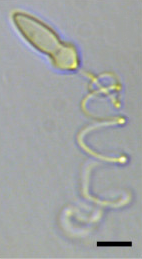| Polykrikos | |
|---|---|

| |
| A light micrograph of Polykrikos kofoidii showing an extruded nematocyst. Scale bar = 10µm.[1] | |
| Scientific classification | |
| Domain: | Eukaryota |
| Clade: | Diaphoretickes |
| Clade: | SAR |
| Clade: | Alveolata |
| Phylum: | Myzozoa |
| Superclass: | Dinoflagellata |
| Class: | Dinophyceae |
| Order: | Gymnodiniales |
| Family: | Polykrikaceae |
| Genus: | Polykrikos Bütschli, 1873 |

Encyclopedia Britannica, 1911

Polykrikos (from Greek “poly” - many, and “krikos” – ring or circle) is one of the genera of family Polykrikaceae that includes athecate pseudocolony-forming dinoflagellates. Polykrikos are characterized by a sophisticated ballistic apparatus,[2] named the nematocyst-taeniocyst complex, which allows species to prey on a variety of organisms. Polykrikos have been found to regulate algal blooms as they feed on toxic dinoflagellates.[3][4] However, there is also some data available on Polykrikos being toxic to fish.[5]
- ^ Hoppenrath, Mona; Bachvaroff, Tsvetan R; Handy, Sara M; Delwiche, Charles F; Leander, Brian S (2009). "Molecular phylogeny of ocelloid-bearing dinoflagellates (Warnowiaceae) as inferred from SSU and LSU rDNA sequences". BMC Evolutionary Biology. 9: 116. Bibcode:2009BMCEE...9..116H. doi:10.1186/1471-2148-9-116. PMC 2694157. PMID 19467154.
- ^ James Gorman (31 March 2017). "First Clear View of a One-Celled Harpooner in Action". NYTimes.com. Retrieved 26 December 2017.
- ^ Gavelis, G.; Wakeman, K.; Ripken, C.; Ozebek, S.; Holstein, T.; Herranz, M.; Keeling, P.; Leander, B. (2017). "Microbial arms race: Ballistic "nematocysts" in dinoflagellates represent a new extreme in organelle complexity". Science Advances. 3 (3): e1602552. Bibcode:2017SciA....3E2552G. doi:10.1126/sciadv.1602552. PMC 5375639. PMID 28435864.
- ^ Nagai, S.; Matsuyama, Y.; Takayama, H.; Kotani, Y. (2002). "Morphology of Polykrikos kofoidii and P. schwartzii (Dinophyceae, Polykrikaceae) cysts obtained in culture". Phycologia. 41 (4): 319. Bibcode:2002Phyco..41..319N. doi:10.2216/i0031-8884-41-4-319.1. S2CID 83728508.
- ^ Tang, Y.Z.; Harke, M.J.; Gobler, C.J. (2013). "Morphology, phylogeny, dynamics, and ichthyotoxicity of Pheopolykrikos hartmannii (Dinophyceae) isolates and blooms from New York, USA". J. Phycol. 49 (6): 1084–1094. Bibcode:2013JPcgy..49.1084T. doi:10.1111/jpy.12114. PMID 27007629. S2CID 12140986.